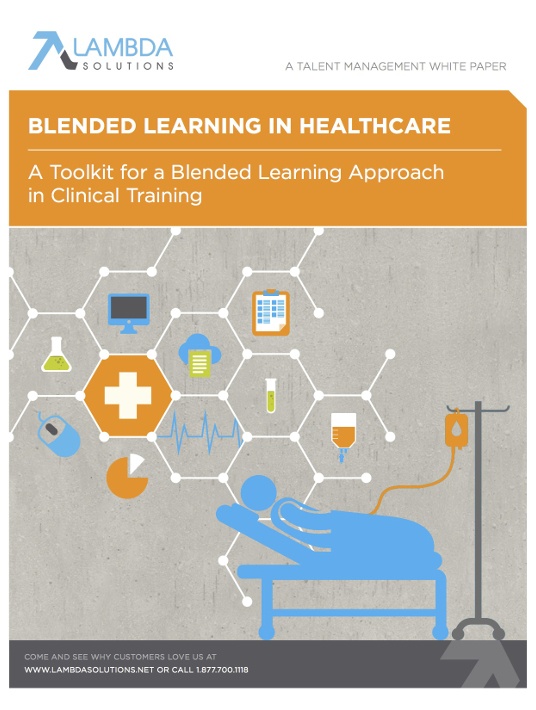The Right Blended Learning Approach: Mixing It All Together With A Learning Management System
In the first part of this article, we discussed the ingredients of a successful blended learning approach in clinical training:
- Online Learning
- Simulations
- Coaching And Mentoring
- Classroom Learning
In this part, we’ll explore the magic in blending these approaches together, as well as what are the best practices for walking a learner population through the parade of curriculum pieces as you accomplish your outcomes.

Blended Learning Magic
First, let’s talk about the magic. Blended learning benefits from the advantages of all of these approaches to provide a very holistic learning experience. Select the right approach for each of the outcomes you want and string them all together. The active learning model, which shifts the responsibility of learning from the teacher to the student, is easier to accomplish when you blend activities into your approach that engage and empower a learner. The blend of the activities is truly where the magic happens.
In Barcelona, a study to measure the impact that a blended learning approach had on students learning anatomy showed a statistically significant increase in test scores for those students who were taught using a blended learning approach[1]. The variety of activities engage areas of the brain that are not able to reinforce each other when learning happens in only one way.
Certainly, based on the evidence found in scores of case-specific blended learning results, the fact that blended learning allows you to chose the teaching modality that best fits the outcome you are hoping to achieve has undeniable benefits over trying to accomplish all of your goals through one teaching approach.
When we look at the barriers to effective blended learning, they seem to focus in on two areas – keeping momentum in the learning journey across the different learning components (especially when the components are separated from one another by significant time) and adjusting the components of the curriculum to reflect recent changes in context or role.
Using these technologies to streamline the learning experience, blended learning is a powerful tool in the clinical training toolbox.
4 Functionalities Of An LMS For An Efficient Blended Learning Approach
While blended learning has proven to be a superior approach to achieving learning outcomes that stick—it is a tad trickier to manage given all the activities that take place. If using the full plethora of tools we’ve outlined for a blended learning approach in clinical training—online learning, classroom learning, simulations, and coaching and mentoring—it is crucial to be able to track, record, and report on the learning that takes place.
Why is this so important? Because learning needs to be tied to measurable performance outcomes so that training and development managers can see what is working and what is not. It is also important because managers need to justify the time and money that is allocated to learning. Let’s take a look at the specific functionalities of a Learning Management System that make a blended learning approach not just possible but efficient.
1. Visibility Into The Learning Journey
With an open source Learning Management System such as Totara LMS, administrators and managers can easily peer into the learning journeys of groups and individual employees to see the learning that has been completed and that progress that has been achieved. Reporting and dashboards allow administrators to peer into the time spent learning both in-class and online.
2. Scheduling Classroom Learning Sessions
A Learning Management System such as Totara LMS also makes it easy for administrators or managers to schedule in-class training or simulation sessions. With automated workflows, Totara LMS makes it easy for employees to browse on-site workshop and training opportunities and directly book online. Registration confirmations will automatically be sent and managers can easily review and approve bookings. Better yet, Totara LMS enables administrators to record attendance within the system so that reporting is seamless.
3. Setting Goals And Managing Performance
A Learning Management System also enables mentors, coaches, and managers to set goals and record progress made. With Totara’s flexible tiered approach, goals can be connected to high-level organizational objectives so that employee performance is directly related to the overarching mission. In order to monitor performance, Totara LMS provides a system for 360-degree feedback by making it easier for managers to ask a wider group of participants for feedback.
4. Competency Management
In the clinical setting, competencies are highly related to patient care and in the same respect, learning and training is highly related to competencies. Using Totara LMS, administrators have the ability to link learning activities to competencies to automatically populate learning paths.
If you want to learn more about how to find the right ingredients for blended learning in Healthcare, as well as how to utilize them for effective blended solutions, download the eBook Blended Learning In Healthcare: A Toolkit For A Blended Learning Approach In Clinical Training.
Footnote:
1. Pereira, Jose A., et al. Effectiveness of using blended learning strategies for teaching and learning human anatomy. Medical education 41.2 (2007): 189-195.









